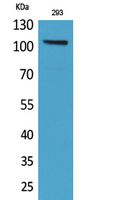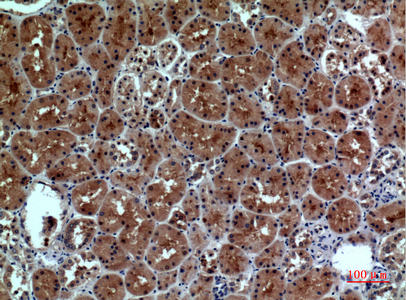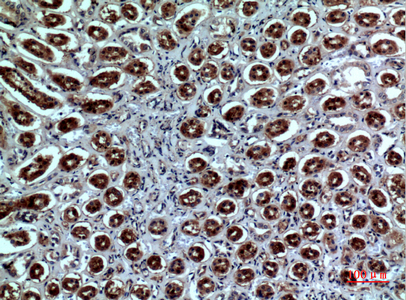


| WB | 咨询技术 | Human,Mouse,Rat |
| IF | 咨询技术 | Human,Mouse,Rat |
| IHC | 1/50-1/100 | Human,Mouse,Rat |
| ICC | 技术咨询 | Human,Mouse,Rat |
| FCM | 咨询技术 | Human,Mouse,Rat |
| Elisa | 1/10000 | Human,Mouse,Rat |
| Aliases | NRP1; NRP; VEGF165R; Neuropilin-1; Vascular endothelial cell growth factor 165 receptor; CD antigen CD304 |
| Entrez GeneID | 8829 |
| WB Predicted band size | Calculated MW: 103 kDa; Observed MW: 100 kDa |
| Host/Isotype | Rabbit IgG |
| Antibody Type | Primary antibody |
| Storage | Store at 4°C short term. Aliquot and store at -20°C long term. Avoid freeze/thaw cycles. |
| Species Reactivity | Human,Mouse,Rat |
| Immunogen | The antiserum was produced against synthesized peptide derived from the Internal region of human NRP1. AA range:321-370 |
| Formulation | Purified antibody in PBS with 0.05% sodium azide,0.5%BSA and 50% glycerol. |
+ +
以下是3篇关于Neuropilin 1(NRP1)抗体的代表性文献摘要:
---
1. **文献名称**:*Structural basis for semaphorin signalling through Neuropilin-1 antibodies via protease-resistant fragments*
**作者**:Appleton BA, et al.
**摘要**:该研究通过X射线晶体学解析了NRP1抗体(如anti-NRP1A和anti-NRP1B)与NRP1胞外结构域的结合机制,发现这些抗体通过靶向NRP1的特定表位阻断其与Semaphorin/VEGF配体的相互作用,为开发抑制血管生成和肿瘤生长的治疗性抗体提供结构依据。
---
2. **文献名称**:*Targeting Neuropilin-1 with monoclonal antibodies inhibits tumor growth in preclinical models*
**作者**:Jia H, et al.
**摘要**:研究报道了一种人源化抗NRP1单克隆抗体(mAb),通过阻断NRP1与VEGF-A的结合抑制肿瘤血管生成和免疫抑制微环境。在结肠癌和乳腺癌小鼠模型中,该抗体显著抑制肿瘤生长并增强化疗疗效,提示其作为癌症联合治疗的潜力。
---
3. **文献名称**:*Neuropilin-1 antibody inhibits SARS-CoV-2 infection by blocking virus entry*
**作者**:Cantuti-Castelvetri L, et al.
**摘要**:研究发现NRP1是新冠病毒(SARS-CoV-2)进入宿主细胞的辅助受体,特异性抗NRP1抗体可阻断病毒刺突蛋白与NRP1的结合,降低体外和动物模型的感染率,为COVID-19治疗提供了新策略。
---
4. **文献名称**:*Dual targeting of VEGF and Neuropilin-1 abrogates joint inflammation in autoimmune arthritis*
**作者**:Yoshida S, et al.
**摘要**:该研究开发了一种双特异性抗体,同时靶向VEGF和NRP1.在类风湿性关节炎模型中显著减少滑膜血管生成和炎症细胞浸润,证实NRP1抗体在自身免疫性疾病中的治疗价值。
---
以上文献覆盖NRP1抗体在结构解析、癌症、病毒感染及免疫疾病中的关键研究。
Neuropilin 1 (NRP1) is a transmembrane glycoprotein that functions as a co-receptor for multiple signaling pathways, notably those involving class 3 semaphorins and vascular endothelial growth factors (VEGFs). Initially identified for its role in neuronal guidance and angiogenesis, NRP1 is now recognized for its broader involvement in immune regulation, tumor progression, and tissue remodeling. Its structure includes extracellular domains that bind ligands and a short cytoplasmic tail mediating intracellular signaling. Dysregulation of NRP1 has been linked to cancer metastasis, aberrant vascularization, and inflammatory diseases, making it a compelling therapeutic target.
Antibodies targeting NRP1 are essential tools for both research and clinical applications. They are designed to block specific ligand-binding domains (e.g., the VEGF-binding b1 domain or semaphorin-binding a1/a2 domains) or modulate downstream signaling. Monoclonal antibodies (mAbs) against NRP1 have been explored in preclinical studies to inhibit tumor angiogenesis, suppress immune evasion in cancers, or mitigate pathological inflammation. Additionally, these antibodies are widely used in techniques like immunohistochemistry, flow cytometry, and Western blotting to study NRP1 expression patterns in normal and diseased tissues. Challenges in antibody development include ensuring specificity to avoid cross-reactivity with NRP2. a closely related homolog, and optimizing pharmacokinetics for therapeutic use. Recent advances in antibody engineering, such as humanized or bispecific formats, aim to enhance therapeutic efficacy while minimizing off-target effects. Overall, NRP1 antibodies represent a versatile toolkit for dissecting biological mechanisms and advancing targeted therapies.
×